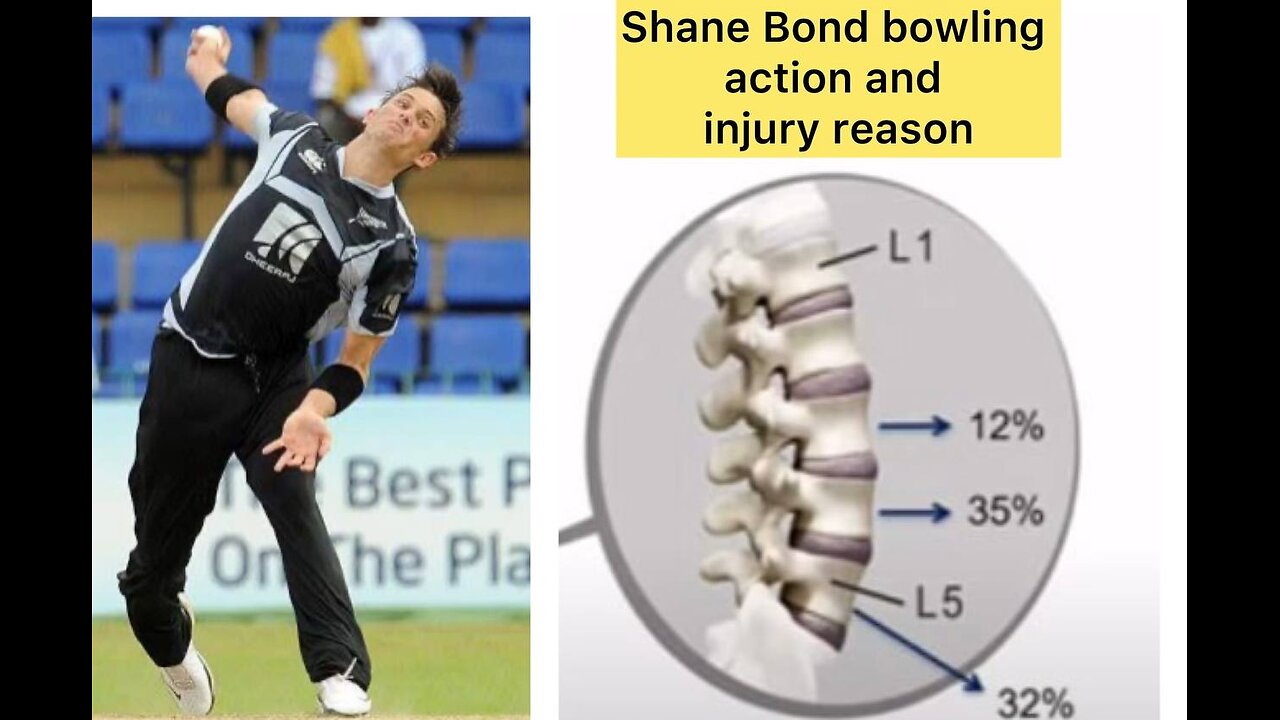Premium Only Content

Shane Bond great yorker bowling and injury woes
Shane Bond bowling .
Shane Bond Action analysis.
Shane Bond Yorker.
Shane Bond slow motion.
Shane Bond best bowling action.
Shane Bond best swing bowling.
Shane Bond bowling action slow motion.
Shane Bond hattrick.
Shane Bond bowling analysis.
Shane Bond injury.
Shane Bond vs India
Shane Bond fastest delivery
Shane Bond bowling analysis.
Shane Bond bowling against Australia.
Shane Bond killer Outswingers.
Shane Bond most amazing bowling.
Shane Bond best bowling spell.
Shane Bond super fast bowling.
Shane Bond fastest ball in cricket .
Lumbar Spine injury
L1,L2,L3,L4,L5.
Fast bowling in cricket can put significant stress on the lumbar spine, and bowlers may be susceptible to various injuries in this area. Lumbar spine injuries can occur due to the repetitive and high-impact nature of the bowling action. Common lumbar spine injuries in fast bowlers include:
Stress Fractures: Repetitive loading on the spine can lead to stress fractures, particularly in the lower back. Stress fractures may occur in the pars interarticularis, a part of the vertebra known as spondylolysis, or progress to a condition called spondylolisthesis where one vertebra slips forward over another.
Disc Injuries: The repetitive hyperextension and rotation involved in the bowling action can lead to disc injuries, such as herniation or bulging discs. This can result in pain, nerve compression, and potentially radiating symptoms into the legs.
Muscle Strains: Muscles in the lower back are heavily involved in the bowling action. Overuse or poor biomechanics can lead to strains in these muscles, causing pain and dysfunction.
Stress Fractures: Repetitive loading on the spine can lead to stress fractures, particularly in the lower back. Stress fractures may occur in the pars interarticularis, a part of the vertebra known as spondylolysis, or progress to a condition called spondylolisthesis where one vertebra slips forward over another.
Disc Injuries: The repetitive hyperextension and rotation involved in the bowling action can lead to disc injuries, such as herniation or bulging discs. This can result in pain, nerve compression, and potentially radiating symptoms into the legs.
Muscle Strains: Muscles in the lower back are heavily involved in the bowling action. Overuse or poor biomechanics can lead to strains in these muscles, causing pain and dysfunction.
Facet Joint Injuries: Facet joints in the spine can be subjected to excessive loading during fast bowling, leading to inflammation, degeneration, or injury.
Nerve Impingement: Repetitive stress on the lumbar spine can lead to nerve impingement, causing conditions like sciatica. This can result in pain, numbness, tingling, or weakness in the lower extremities.
Preventing Lumbar Spine Injuries in Fast Bowlers:
Proper Technique: Ensuring that bowlers use correct technique is crucial. Coaches should focus on biomechanics to reduce stress on the lumbar spine.
Core Strengthening: A strong core can provide better support to the lumbar spine. Including core-strengthening exercises in training programs can be beneficial.
Flexibility Training: Improving flexibility in the hips, hamstrings, and lower back can help reduce the strain on the lumbar spine during the bowling action.
-
 56:08
56:08
State of the Second Podcast
14 hours agoWhat does the next 4 years look like for the suppressor market? (Ft. Rugged Suppressors)
231 -
 29:08
29:08
The Lou Holtz Show
8 hours agoThe Lou Holtz Show Ep 21 | Enes Kanter Freedom: A Voice For Human Rights #podcast
12 -
 28:31
28:31
America First Policy Institute
15 hours agoAmerica First Policy Institute Gala Donald Trump, Elon Musk & Sylvester Stallone Ignite the Movement
17 -
 4:36
4:36
BIG NEM
5 hours agoThe Sad Truth About How Our Cannabis is Grown
661 -
 LIVE
LIVE
Price of Reason
10 hours agoMainstream Media FEARS Extinction! Gladiator 2 Review! New DnD SCANDAL!
3,883 watching -
 LIVE
LIVE
Fresh and Fit
6 hours agoIsrael-Hezbollah Ceasefire & Reacting To Death Threats On X
6,106 watching -
 1:11:10
1:11:10
Steve-O's Wild Ride! Podcast
5 days ago $7.11 earnedDusty Slay Went From Selling Pesticides To Having A Netflix Special - Wild Ride #244
21.1K3 -
 1:16:02
1:16:02
CocktailsConsoles
4 hours agoBE PART OF THE GAME!!| Death Road to Canada | Cocktails & Consoles Livestream
13.9K1 -
 LIVE
LIVE
Phyxicx
6 hours agoWe're streaming again! - 11/26/2024
215 watching -
 LIVE
LIVE
GamingWithHemp
6 hours agoHanging with Hemp #103
1,258 watching